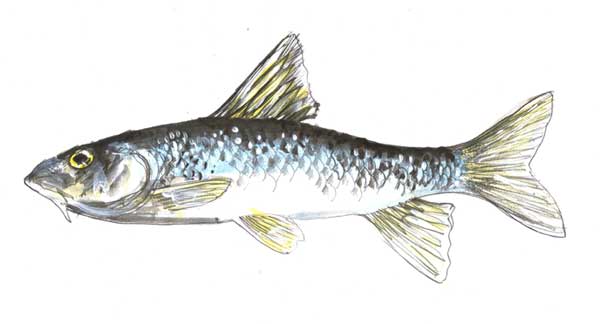
Gudgeon (Gobio gobio)
Current record: 5oz
Water: River Nadder, Sutton Mandeville
The gudgeon, a small freshwater fish belonging to the Cyprinidae family, is widely distributed in rivers and streams across Europe and parts of Asia. Known for its slender and elongated body, the gudgeon typically exhibits shades of silver, bronze, or olive, with a pale belly. While its size is modest, ranging from 4 to 8 inches in length, the gudgeon is recognized for its interesting behavior and role in freshwater ecosystems.
Gudgeon are bottom-dwelling fish that prefer clear and slow-moving waters, often occupying areas with gravel or rocky substrates. Their habitat choice provides them with ample opportunities to feed on small invertebrates, aquatic insects, and plant matter. Gudgeon use their small mouths to forage along the riverbed, contributing to the overall balance of aquatic ecosystems by controlling the populations of various organisms.
Anglers appreciate the gudgeon for its willingness to take bait and its sporty nature, making it a popular catch in recreational fishing. Given their small size, they are often caught using light tackle and small hooks. While not typically targeted for their culinary appeal, gudgeon provide an enjoyable angling experience, especially for novice anglers.
In terms of reproduction, gudgeon engage in communal spawning, where multiple individuals release their eggs and sperm simultaneously. This synchronized approach is believed to increase the chances of successful fertilization. The eggs attach to rocks or other submerged structures, and the newly hatched fry remain in shallow, protected areas until they grow large enough to venture into the main river channel.
Conservation efforts related to gudgeon focus on maintaining the health of their habitats, particularly by addressing issues such as habitat degradation, water pollution, and alterations to water flow. Recognizing their role in nutrient cycling and the interconnectedness of freshwater ecosystems, conservationists work to implement measures that support the overall well-being of gudgeon populations and the aquatic environments they inhabit. Understanding the ecological importance of these unassuming fish contributes to the broader goals of preserving biodiversity and ensuring the sustainability of freshwater ecosystems.
The gudgeon forages for worms, aquatic insects and larvae, small mollusks, eggs, and fry as it swims in shoals over sandy and gravelly bottoms. It often operates during the day. It has the ability to make squeaking noises, which are thought to be a kind of interpersonal communication. It reproduces in rocky, shallow waters. When the water temperature is above 13 °C, which occurs from April to August, eggs are laid. Before sticking to the bottom, the eggs drift with the current after being released above the substrate. The larvae and young consume bottom-level debris. The fish can survive for up to five years, with fingerlings growing to a height of about 12 cm (4.7 in) in their first year.
Many fish-eating carnivores, such as the Eurasian otter and common kingfisher, regularly feast on goudons. Gudgeon is the most pursued fish prey in Central Europe, representing up to 45% of the common kingfisher's diet on streams and rivers (by numbers, often between 25 and 35%).